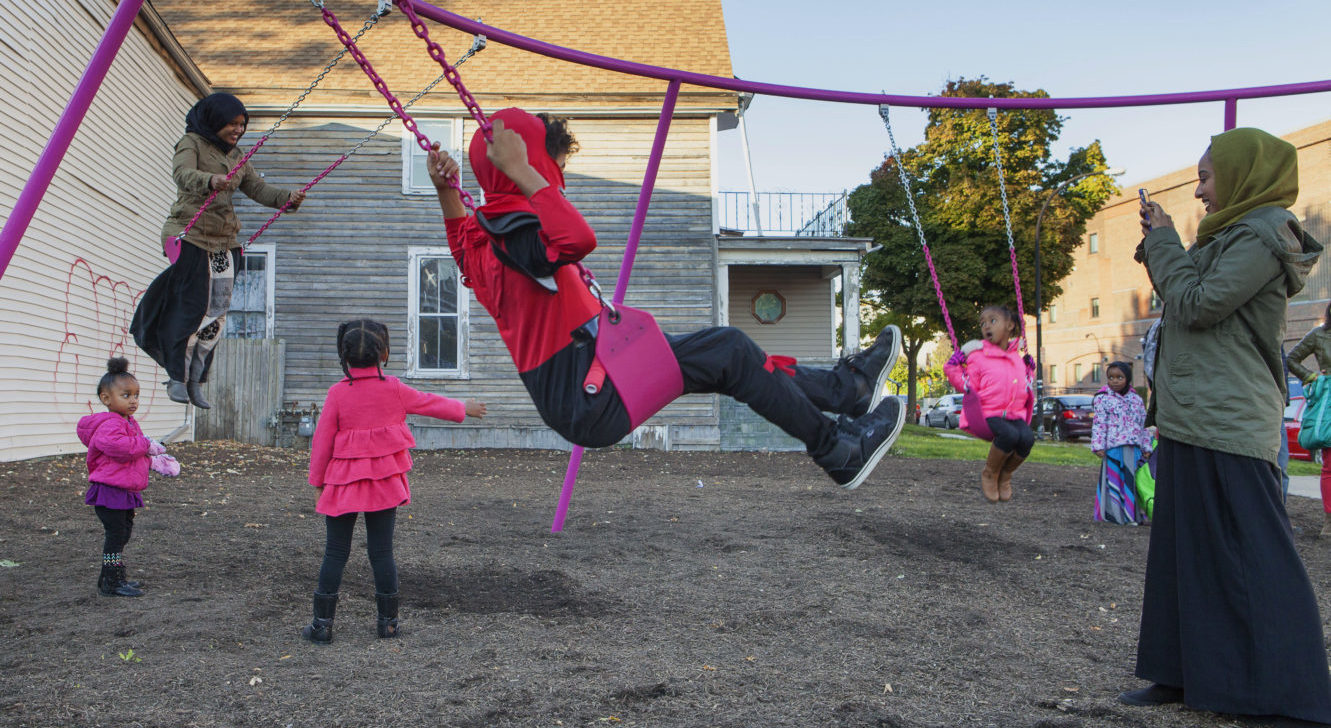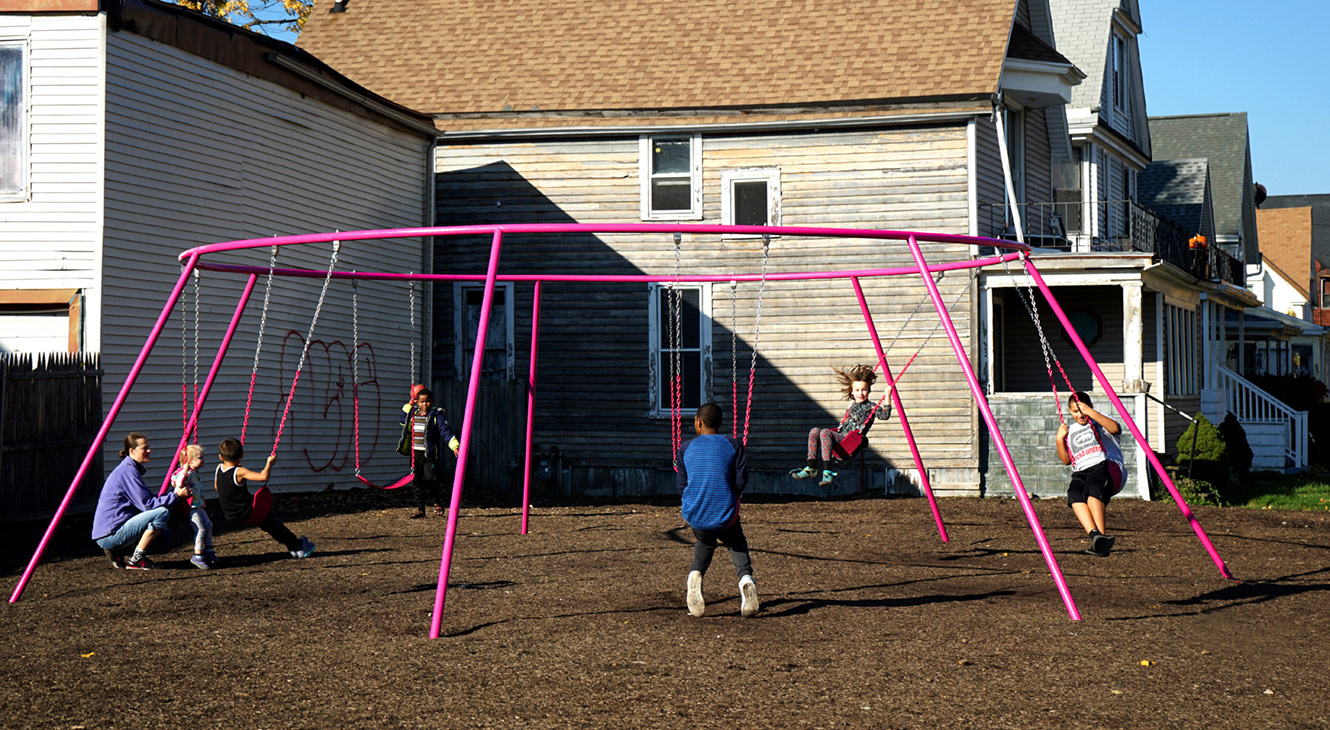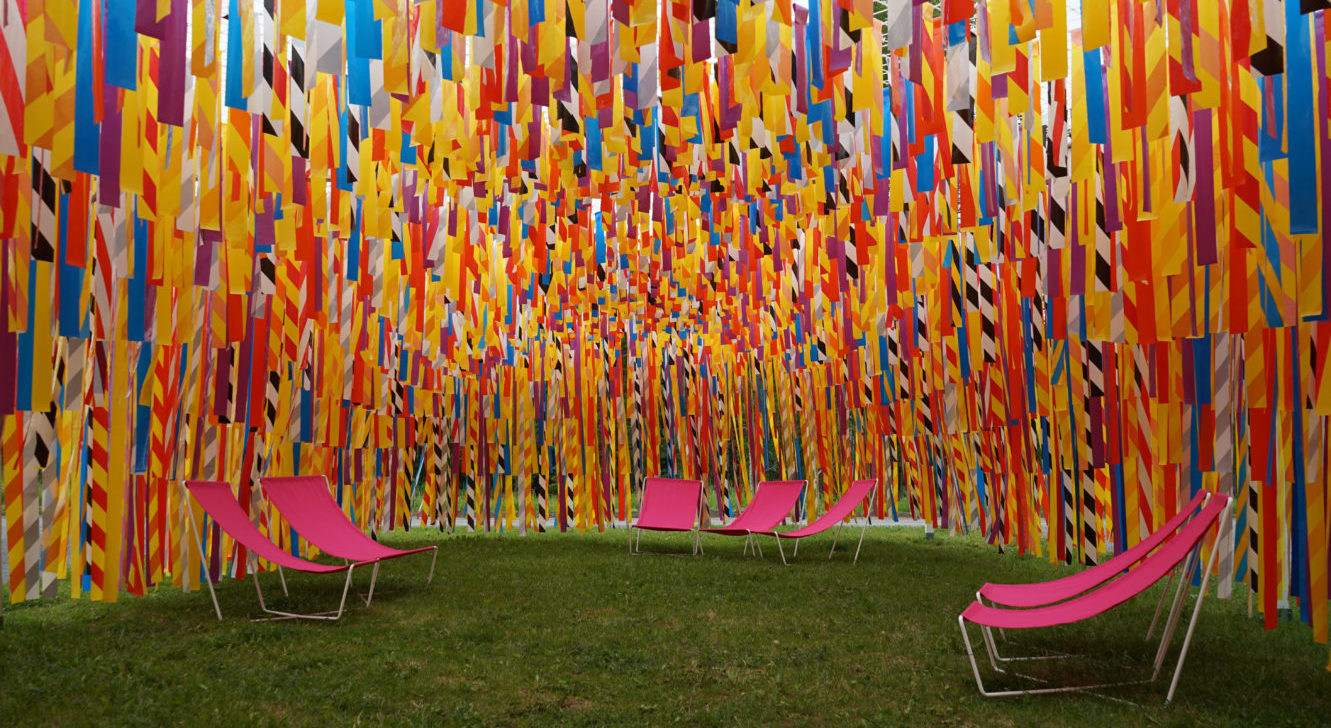So much more than a swing set
Architect Coryn Kempster creates environments that foster social interaction.
April 26, 2018

Coryn Kempster and Julia Jamrozik | Full Circle, Buffalo, New York, 2016. Commissioned by CEPA Gallery and C.S.1 Curatorial Projects. Credit: Brendan Bannon
An interview with Coryn Kempster, a partner at Julia Jamrozik and Coryn Kempster and a recipient of the 2018 League Prize.
How can designers strengthen urban social connections—on a small budget? Architect Coryn Kempster and his partner, Julia Jamrozik, create experimental designs that inject new possibilities for human interaction into rust belt cities, one empty lot at a time.
Kempster spoke to the Architectural League’s Catarina Flaksman and Antonio Huerta about his work.
*
Antonio Huerta: We’re interested in how your work interacts with public space, and how it can promote shared experiences and dialogue. How do these issues play out in the playgrounds you’ve done?
Coryn Kempster: We don’t think about it like we’re designing playgrounds—it’s more like we’re using elements from playgrounds as an opportunity to create social space. We call them “social infrastructure”—something that brings people together and offer moments of connection. The swing is a familiar element, something everybody knows and immediately understands how to use. It’s a way of making our work accessible.
In Buffalo, but also in most places we’ve lived or visited, you get a diversity of people from different economic, social, and racial backgrounds in playgrounds that you simply don’t find elsewhere in the city. All the people living in the city come together and interact with one another. That’s very interesting to us, living in a city which is otherwise extremely racially and economically segregated.
In our digital age, people live in online echo chambers. What we want to do is to create analog prompts for real-life interactions. If we can create real, physical moments when people can meet, maybe it could make the tiniest contribution to all of us getting along better.
If we can create real, physical moments when people can meet, maybe it could make the tiniest contribution to all of us getting along better.
Catarina Flaksman: How would you characterize the existing public spaces in Buffalo?
Kempster: [Frederick Law] Olmsted designed a pretty extensive system of parks and parkways, and that’s something that Buffalonians are intensely proud of. Olmsted left this park system as a legacy to the city—which is also quintessentially Buffalo in that it comes from a moment when it was actually a very important city.
Buffalo was absolutely awash in money in the late 1800s. You can still see remnants of that wealth today, even though it’s a rust belt city. It fell on hard economic times, but it’s starting to have a resurgence now, and there are very palpable markers of that already. But it’s clear that the city was built on a grand scale, with grand amenities.
That’s the defining feature of public space in Buffalo, historically. But I think what’s missing is a finer-grained scale of intervention. Buffalo’s residential neighborhoods need small parks and public spaces where people can gather on a more day-to-day basis, as opposed to the typical activity of getting in their car and driving to the Olmsted parks, then driving back home.
Flaksman: Was Full Circle the first public space you designed for Buffalo?
Kempster: Yeah, and it speaks to a lot of these issues.
It’s on a vacant lot on Buffalo’s West Side. Like a lot of rust belt cities, Buffalo has an enormous stock of empty lots. The idea to put a project on an empty lot actually came from CEPA Gallery, which did a half dozen projects on empty lots on the West Side.
But that really got us thinking about the potential these lots have. Full Circle was a prototype for what we could do with them. Not that every empty lot needs social infrastructure, but you could create a network of spaces at the scale of single vacant lots throughout the West Side, or maybe even the entire city.
We’ve been very inspired by Aldo van Eyck’s idea of the city as a playground. He focused on scattering a lot of small interventions across the city instead of creating large parks and interventions.
When we say we’re not so interested in playgrounds per se, but in the prompt they offer to invite people of all ages to occupy a space, that’s coming directly from Van Eyck, who was careful to ask what happens to play equipment at night, once kids go to bed.
Full Circle is an example of that. While we like that it gets used by children, and sometimes parents, during the day, in the evenings and at night teenagers are hanging out there too. It’s not just what you might think of a typical playground.
Flaksman: What kind of reactions do you get from the neighbors?
Kempster: When Full Circle was being installed, we got a lot of attention from the neighbors. Most of them were very positive and that made us very excited and happy.
It’s been really heartwarming to see the social media response. Someone recently wrote: “My daughter loves that set of swings. Every nationality, kids swinging, talking, hanging out peacefully. It’s so much more than a swing set to us.”
That, for us, is perfect. It embodies everything.
Huerta: Your work is very colorful. Is there a relationship between color and creating spaces for play?
Kempster: We’re certainly interested in color, and part of it is a reaction to the contemporary age of beige. It’s amazing how, as recently as the ’70s, people would buy avocado green appliances to put in their kitchen. Americans used to have a lot more fun with color in their daily lives.
We inject full-on, unapologetic color into our work as a very easy way to make it contrast with its surroundings. It’s like a bird’s feather display––a way of attracting people by saying “Hey, look at us.”
For playgrounds, we’re careful to avoid strictly primary colors. We’re trying to generate a slightly more sophisticated response in terms of color, which children are quite attuned to.
Sometimes we try to add a political flavor to our color choices. Last year we were inspired by the MAGA and pussy hats that were everywhere, so we made a red and pink sculpture that was all about encouraging strangers who might otherwise not talk to each other to interact.
Flaksman: Are you currently working on public spaces? And do you intend to expand outside of Buffalo?
Kempster: Yes to both.
The Ralph C. Wilson, Jr. Foundation has recently teamed up with a non-profit organization called KaBOOM! to offer grants to create play spaces in Western New York. There could be a lot of synergy with our idea of small-scale interventions. We’re throwing everything we’ve got at applying for those grants. I think we made 12 proposals for the first stage of review. We’re really excited about that.
We also just started fabricating a tubular steel interactive sculpture for Toronto, which is meant to create a space for people to hang out, talk to each other, and interact in public space. We’re very excited about that as well. It will be installed in May on King Street.
And we just finished another swing set, actually, in Buffalo. This was a continuous line of seven swings all linked to one another. So we’re definitely pushing that direction as much as we can.
Huerta: Do you have a broader vision for Buffalo?
Kempster: Wow, that’s a big question. Like some of the other rust belt cities, Buffalo is making an economic recovery that’s very positive and exciting. We’ve come to Buffalo at a really good moment, because we get to participate in that revival.
If we have a vision for Buffalo, it’s that we are committed to pushing this strategy of intervening at the scale of the empty lot in a dispersed manner across the city. It’s a simple and relatively inexpensive, but hopefully very effective, way of improving the residential neighborhoods of the city for the benefit of the people who live there.
Buffalo’s recent economic success has been focused on very specific neighborhoods. That’s just the reality of this kind of regenerative process. But the result is that you get intense development and a lot of money put in exactly where that development is happening, while other neighborhoods sit on the sidelines. Nothing happens directly for them.
It’s important to find ways to help those neighborhoods, and also create public investment there.
Interview edited and condensed.
Explore
The architecture of the everyday
For Stephanie Davidson and Georg Rafailidis, mundane issues like the weather and mortgages serve as a springboard for design investigation.
Connective spaces and social capital in Medellín
Jeff Geisinger investigates the built environment's impact on social capital in Colombia's second-largest city.
Re-envisioning New York’s branch libraries
The Center for an Urban Future's latest policy report provides a comprehensive blueprint for bringing these vital community institutions into the 21st century.




